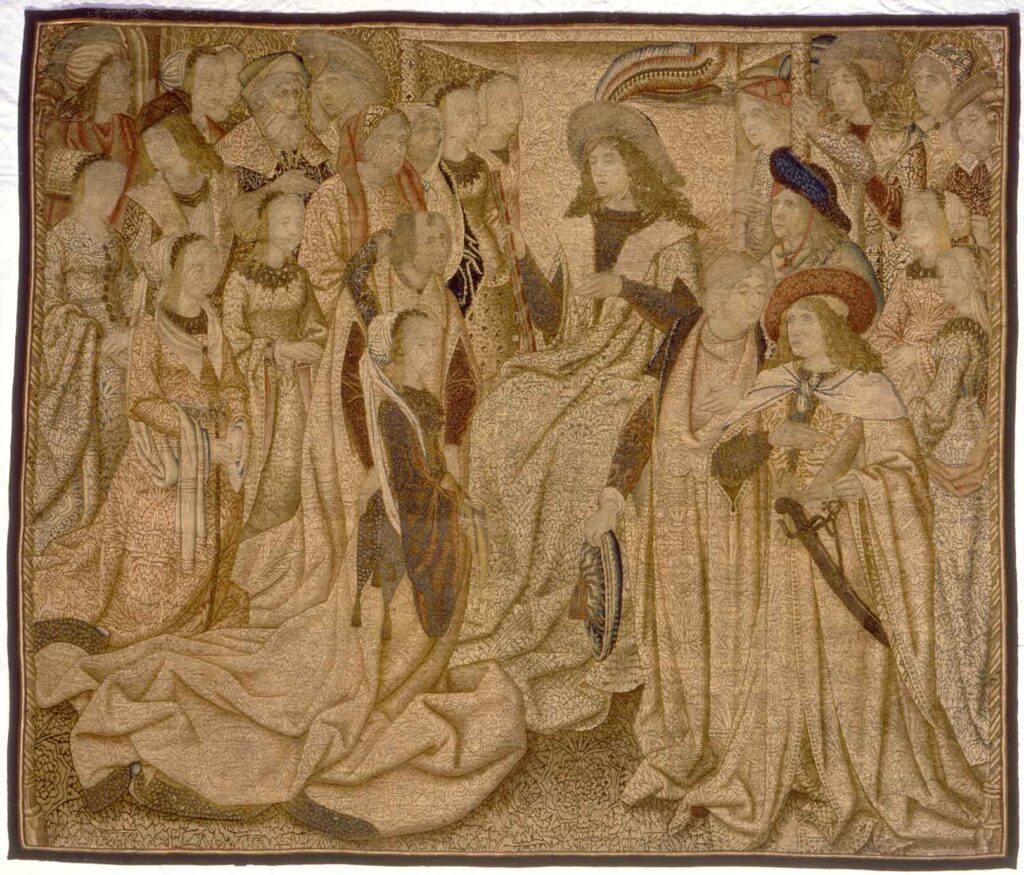Tapestry with Esther presented to Ahasuerus
Brussels , 1490 - 1510
Description

In the center is a young man on a throne holding in his right hand a kind of bundle formed by sticks tied together. Kneeling before him is a maiden, presented by a man of advanced age. All around attend courtiers and ladies. On the sword of the figure depicted on the right in the foreground is the inscription shown in the second attached photo. The deciphering is uncertain, but it should be a heraldic or symbolic motto, and not a signature or indication of origin as sometimes appears in coeval tapestries (for the issue, see Steppe, 1976, pp. 193-230). The selvedge is modern.
It may be that the cloth was originally surrounded by a decorated border, which has been lost; but also that it was the central part of a larger, compartmentalized tapestry, and that other scenes were flanked and/or superimposed on it. In 1889 the tapestry was described as being in “good preservation” (Collection of Angelo de Amici […], p. 40), however, in 1899 it underwent restoration by “upholsterer” Carlo Galbusera (Museo Poldi Pezzoli Archives, faldone 14/a, attachment 68, July 17). In 1981, reduced to an advanced state of decay, a scientific restoration was decided upon, conducted by Francesco Pertegato under the direction of Alessandra Mottola Molfino, on the Museum’s own premises, which restored the tapestry to an optimal state of preservation (cf. Mottola Molfino, work in progress).
The subject has been variously interpreted. In 1889 (Collection of Angelo de Amici […], p. 40) Assuerus with genuflected Esther was recognized in it. The extender of the aforementioned catalog (perhaps Giulio Sambon, who signed the Foreword) indicated a provenance from a “Flemish factory” and proposed the date “first half of the 15th century,” evidently fanciful. Interesting, however, is the reference to “works […] from that period” preserved “in the Royal Palaces of Spain.” Indeed, similar compositional structures are found in the so-called “Paños de Oro” with the Life of the Virgin in the Royal Palace of Madrid. One episode, depicted in the upper left of the tapestry God the Father sends the archangel Gabriel to Mary, shows a young man before whom a maiden is genuflected, presented by an aged man and surrounded by bridesmaids.
Souchal (1975, pp. 141-143) recognizes in it a scene from Esther, II, 8-18: having repudiated Queen Vasti, Ahasuerus orders that the most beautiful maidens of the kingdom be brought to him; Esther manages to be among the chosen ones, and by the eunuch Aegeus she is presented to Ahasuerus, who falls in love with her. It seems unlikely that the Poldi Pezzoli tapestry also depicts this biblical episode. According to Schmitz (1921, p. 206) it would instead depict Solomon and the Queen of Sheba; of the same opinion are Morassi (1932, p. 6) and Wittgens (1937, p. XIII).
In Bourgondische Pracht ([…], 1951, p. 45) and in Le Siècle de Bourgogne ([…], 1951, p. 68) the title defined as “traditional,” of Solomon and the Queen of Sheba, is retained, but a different interpretation of the subject is also suggested: that is, it would be a scene of justice in ancient Rome, because of the bundle-shaped staff in the hand of the enthroned figure. In any case, the tapestry is certainly part of that complex of vestments and cloths that, by stylistic similarities with documented works, can be referred to tapestry manufactures operating in Brussels between the last years of the 15th and the first two decades of the 16th century. A specific feature of the Poldi Pezzoli tapestry is the decorative effect achieved by means of a particular technique: that is, the accurate reproduction of contemporary Italian fabric designs in the clothing of the characters and the furnishings of the scene.
Data Sheet
Author
Brussels
Date
1490 - 1510
Material and technique
wool; silk; silver threads; gilt silver threads
Measures
254 cm x 298 cm
Acquisition
1890
Inventory number
0327
location
Stanza dei tessuti
Like the Fresco Room and the Collector’s Room, the Textile Room is also dedicated to hosting temporary exhibitions. Over time it has changed several uses: after World War II it was prepared for the display of carpets and archaeological objects, then the Museum’s textile collections.
collection
Textiles
The heterogeneous textile collection includes important antique Persian carpets, Renaissance tapestries and 180 textiles dating from the 14th to the 18th century. Among them, rare Italian velvets and precious 15th century Lombard altar frontals. Antique Coptic textiles and Lombard and Flemish laces and embroideries, dating from the 18th and the 19th century, were acquired or received as donations.
